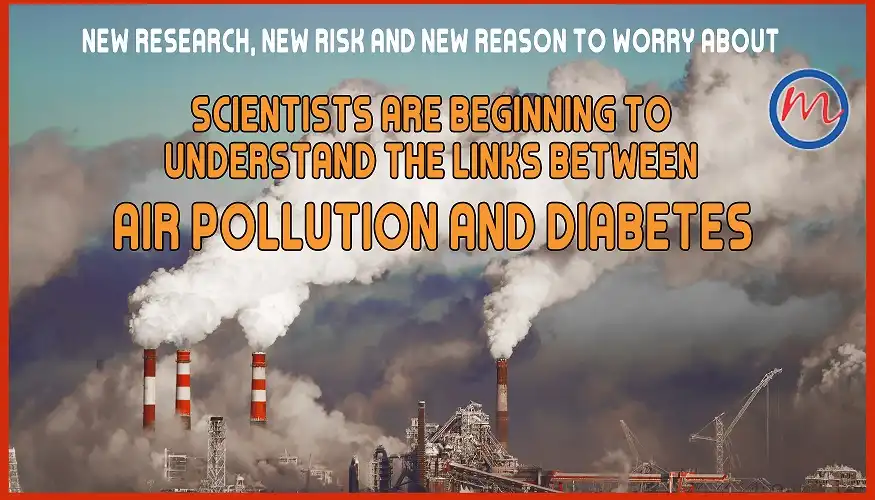Diabetes has always baffled doctors and scientists. They have tried to
understand for long what exactly causes diabetes, how it happens, why some people are at higher risk. So long, poor diet, lack of exercise, family history, overweight and age have been blamed for contributing to type 2 diabetes. But now, it seems, there is also an ‘X factor’ at play. A host of new global studies are pointing to an additional, surprising culprit: air pollution.
We know that air pollution is the world’s leading environmental risk factor and causes more than nine million deaths per year due to stroke, heart disease, lung cancer and chronic respiratory diseases. New research now shows that air pollution may play a role in the development of cardiometabolic diseases, such as diabetes.
WHAT ARE CARDIOMETABOLIC DISEASE?
Cardio means heart, while metabolic means the process the body uses to break down nutrients and generate energy. Cardiometabolic diseases combine a derangement of both the systems, characterized by insulin resistance, impaired glucose tolerance, abnormal cholesterol levels, high blood pressure and central adiposity (too much fat around the waist).
Recognized now as a disease entity by the World Health Organization (WHO), people with cardiometabolic diseases are two times more likely to die from heart disease and three times more likely to have a heart attack or stroke than those who do not have it. Excess fat in the tummy is now known to be a major contributor to increased cardiometabolic risk.
WHAT’S REALLY AT WORK?
These diseases are rising at a much faster clip in countries that are undergoing rapid economic transformation, like India. The relationship between economic growth and environmental pollution has been a longstanding global concern since the 1970s. Scholars have shown that in countries with lower levels of economic development, rise of industrial activities bring about environmental deterioration.
Gradually, as economic growth leads toward the development of services and knowledge-based, technology-intensive industries, the environmental degradation trend declines. This happens due to environmental awareness, the replacement of dirty and obsolete technologies by upgraded and cleaner technologies that improve environmental quality and stricter environmental regulations.
THE MAIN CULPRIT
As scientists delve deeper, particulate matters (PM, also called particle pollution) or the complex mixture of solid and liquid particles suspended in air, have emerged as the new villains. PM can include both organic and inorganic particles, such as dust, pollen, soot, smoke, and liquid droplets. They vary greatly in size, composition, and origin.
They are either directly emitted, for instance, by various types of industry, when fuel is burnt or when dust is carried by wind. Or they are formed indirectly, by air contaminants emitted into the atmosphere: for instance, oxides of nitrogen (NOx) and Sulphur (SOx), volatile organic compounds (VOCs), ammonia, organic compounds and other gases that react in the atmosphere and produce PM.
The biggest source of particulate matter is cars, trucks, buses, airplanes, trains and ships. In particular, particulate matter PM2.5 is under scanner. Usually invisible to the human eye—PM2.5 is 2.5 micrometers big, or 30 times smaller than a human hair—a lot of PM2.5 in the air make the air look smoggy or hazy. Scientists are just beginning to understand what exactly makes PM2.5 so harmful. A major reason seems to be that it’s so small and contains toxic metals.
HOW THEY WORK
Though other research has shown a link between diabetes and air pollution in the past, it is 2018 The Lancet Planetary Health study that reported exposure to PM2·5 air pollution is indeed a risk factor for diabetes: an increase in PM2·5 increases the risk of diabetes. Although the exact biological mechanisms whereby air pollutants cause diabetes are not entirely clear, several plausible mechanisms have been proposed.
The airborne microscopic pieces and droplets can enter the lungs and invade the bloodstream. One hypothesis is that they lead to greater oxidative stress (inability to remove toxic oxygen molecules) and inflammation, which further results in abnormalities in insulin mechanism, preventing the body to convert blood glucose into energy. Another hypothesis is that they cause imbalance of the autonomic nervous system (which controls internal organs like digestion and heartbeat). As a result, they directly affect insulin resistance.
IN DEVELOPING COUNTRIES
Health effects of air pollution on diabetes have been scarcely studied in developing countries. Lancet Planet Health 2018 has focused on China and found long-term exposure to air pollution associated with increased risk of diabetes. Additionally, it has been observed that the effects of PM10 and NO2 are stronger than other air pollutants, especially on younger, overweight or obese participants, compared to older people with normal body weight. The associations for air pollutants with diabetes are also generally stronger in men than in women, for the less educated than the highly educated and for current smokers than former or non-smokers.
China has had a concerning rise in the incidence of diabetes during the past two decades. Meanwhile, air pollution has become one of the most serious environmental health issues in China. Given the grave public health implications of the diabetes epidemic and the ubiquitous nature of ambient air pollution, exploration of the association between air pollution and diabetes in China is crucial for the development of preventive measures.
The study indicates that exposure to a range of particulate pollution—PM1, PM2·5, PM10, SO2, NO2, and O3—might adversely affect the risk of developing diabetes. Given the coexistence of high air pollution and a diabetes pandemic in China, as in other middle-income countries, the results are of significance to public health. The Lancet studies call for action from policymakers, to prioritize the rapid development and implementation of air quality improvement interventions to decrease air pollution-induced risks of diabetes.
THE LATEST LINK
One of the largest studies on the air pollution-diabetes link has been published in the Journal of Clinical Investigation on August 20, 2020. Researchers of the University Hospitals Cleveland Medical Center, US, have quantified exactly how many diabetes cases in the world are attributable to air pollution: 14 percent in 2016 alone.
In the United States, it found, air pollution is responsible for 150,000 cases of diabetes. Among people exposed to 5—10 μg/m3 of particulate matter, about 21 percent developed diabetes. For each 10 μg/m3 increase in particulate matter, the risk of developing diabetes goes up by 15 percent. This risk is present regardless of whether the individual becomes obese or not.
WHAT’S THE SOLUTION?
The only solution is to avoid large amounts of particulates. To begin with, live away from major sources of emission and congested road systems. Wear masks anywhere there’s high pollution. Don’t ride bicycles or engage in strenuous physical activity during rush hour or near major roadways.
The real answer, however, lies with public policy. The consequences of PM2.5 are more severe for developing countries, where strict limits on air pollution are not followed. We have to rally for stricter limits on fossil-fuel emissions and a move to cleaner energy sources. And in our personal lives, we have to follow all the norms. Remember, air pollution and diabetes are responsible for millions of death globally.



